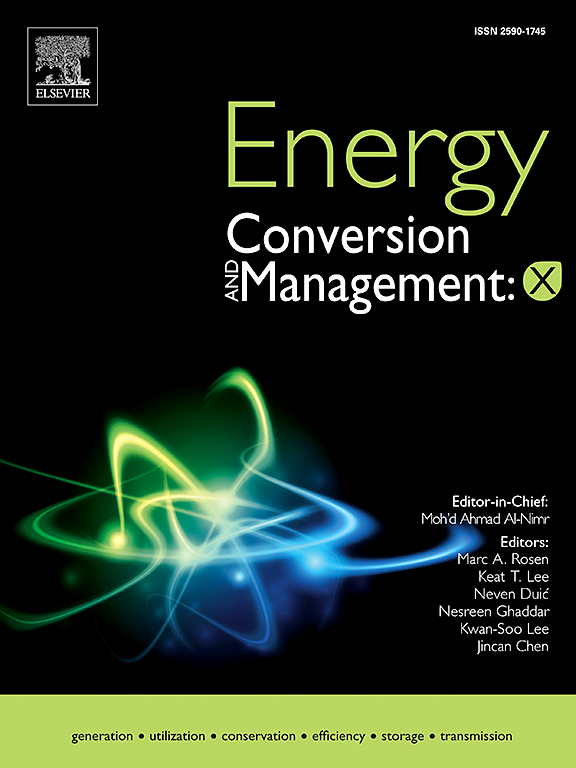Performance evaluation of solar and condensing heat recovery systems for air reheating and humidification in industrial buildings
IF 10.9
1区 工程技术
Q1 ENERGY & FUELS
引用次数: 0
Abstract
Ensuring precise control of temperature and humidity is critical for maintaining process reliability and energy efficiency in industrial building environments. However, conventional heating, ventilation, and air conditioning (HVAC) systems often overlook the recovery of low-grade waste heat and the integration of renewable energy, resulting in low operational efficiency and high energy costs. To address this issue, this study proposes an air conditioning system that integrates solar energy and condensation heat recovery, and establishes a coupled heat and humidity control strategy that simultaneously utilizes recovered heat for both air reheating and humidification. The system’s performance is comprehensively evaluated from the perspectives of energy, exergy, and economic efficiency. Furthermore, a multi-objective optimization framework combining artificial neural networks (ANN) and the multi-objective grey wolf optimizer (MOGWO) is developed to determine the optimal capacity configuration. The results demonstrate that, compared with traditional electric reheating systems, the proposed waste heat recovery (WHR) air conditioning system achieves a coefficient of performance (COP) of 6.08 and reduces the levelized cost of heat (LCOH) to 0.079 USD/kWh during the heating season, highlighting substantial improvements in energy efficiency and cost-effectiveness. In the non-heating season, the system also exhibits stable operation and effective cost control. Based on the technique for order preference by similarity to ideal solution (TOPSIS) decision-making method, a representative configuration optimized for the heating season is recommended for year-round operation, featuring a thermal storage tank volume of 59 m3 and a solar collector area of 594 m2. This configuration ensures an annual COP of at least 4.3, an exergy efficiency above 0.18, and an LCOH not exceeding 0.081 USD/kWh. This study confirms the feasibility of coupling low-grade waste heat with renewable energy in HVAC systems and provides a high-efficiency, cost-effective, and scalable solution for achieving low-carbon building operations in industrial environments.
工业建筑空气再加热和加湿用太阳能和冷凝热回收系统的性能评价
确保精确控制温度和湿度对于保持工业建筑环境中的过程可靠性和能源效率至关重要。然而,传统的暖通空调(HVAC)系统往往忽视了低品位废热的回收和可再生能源的整合,导致运行效率低,能源成本高。为了解决这一问题,本研究提出了一种集成太阳能和冷凝热回收的空调系统,并建立了一种热湿耦合控制策略,同时利用回收的热量进行空气再加热和加湿。系统的性能从能源、能源和经济效率的角度进行综合评价。在此基础上,建立了人工神经网络(ANN)和多目标灰狼优化器(MOGWO)相结合的多目标优化框架,确定了最优容量配置。结果表明,与传统的电再加热系统相比,所提出的余热回收(WHR)空调系统在采暖季的性能系数(COP)为6.08,平均热成本(LCOH)降至0.079美元/千瓦时,能效和成本效益均有显著提高。在非采暖季,系统运行稳定,成本控制有效。基于TOPSIS(相似理想解决方案)决策方法的顺序偏好技术,推荐了针对采暖季节优化的具有代表性的配置,用于全年运行,其特点是储热罐容积为59 m3,太阳能集热器面积为594 m2。该配置可确保年COP不超过4.3,火用效率不超过0.18,LCOH不超过0.081美元/千瓦时。本研究证实了在暖通空调系统中将低品位废热与可再生能源相结合的可行性,并为实现工业环境中的低碳建筑运营提供了一种高效、经济、可扩展的解决方案。
本文章由计算机程序翻译,如有差异,请以英文原文为准。
求助全文
约1分钟内获得全文
求助全文
来源期刊

Energy Conversion and Management
工程技术-力学
CiteScore
19.00
自引率
11.50%
发文量
1304
审稿时长
17 days
期刊介绍:
The journal Energy Conversion and Management provides a forum for publishing original contributions and comprehensive technical review articles of interdisciplinary and original research on all important energy topics.
The topics considered include energy generation, utilization, conversion, storage, transmission, conservation, management and sustainability. These topics typically involve various types of energy such as mechanical, thermal, nuclear, chemical, electromagnetic, magnetic and electric. These energy types cover all known energy resources, including renewable resources (e.g., solar, bio, hydro, wind, geothermal and ocean energy), fossil fuels and nuclear resources.
 求助内容:
求助内容: 应助结果提醒方式:
应助结果提醒方式:


